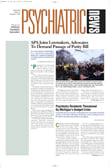In their fight against the pernicious effects of media violence on children, psychiatrists might be pleased to learn that pediatricians are giving them some help. The American Academy of Pediatrics (AAP) has published a new policy statement on media violence in the November issue of its journal, Pediatrics.
Assisting in the development of the statement was a Washington, D.C., child psychiatrist who has been combating the destructive effects of media violence on young people, and he did so on behalf of the American Academy of Child and Adolescent Psychiatry. He is Michael Brody, M.D., chair of AACAP’s television and media committee and liaison to AACAP’s committee on public education.
“It is important that we hammer away at this topic,” Brody told Psychiatric News. “This is a public health issue that needs the support of medical organizations like AAP and AACAP.”
The AAP policy statement highlights the overwhelming evidence showing that media violence can hurt youngsters. “More than 3,500 research studies have examined the relationship between media violence and violent behavior,” the statement declares. “All but 18 have shown a positive relationship. . . .” What’s more, the statement points out, “The strength of the correlation between media violence and aggressive behavior found on meta-analysis is greater than that of calcium intake and bone mass, lead ingestion and lower I.Q., condom nonuse and sexually acquired human immunodeficiency virus infection, or environmental tobacco smoke and lung cancer—associations clinicians accept and on which preventive medicine is based without question.”
The statement goes on to say that “interactive media, such as video games and the Internet, are so new that there has been little time to assess their influence on children’s physical and mental health. [However,] early studies of these rapidly growing and ever-more-sophisticated types of media indicate that the effects of child-initiated virtual violence may be even more profound than those of passive media, such as television. . . . Although exposure to media violence is not the sole factor contributing to aggression, antisocial attitudes, and violence among children and adolescents, it is an important health risk factor on which we, as pediatricians and as members of a compassionate society, can intervene.”
The statement includes recommendations on the subject, notably these:
• Pediatricians should incorporate a “media history” into annual health maintenance exams and, as with seat belts and bike helmets, suggest healthy alternatives, such as sports, creative pursuits, interactive play, and reading for children at risk. When heavy media use by a child is identified, pediatricians should evaluate the child for aggressive behaviors, fears, or sleep disturbances and intervene appropriately.
• Pediatricians should encourage parents, schools, and communities to help children become “media literate” so that they can protect themselves from the destructive influences of media violence. In other words, young people should learn how the media can influence the ways that people perceive reality and how to reject media messages that are not psychologically healthy since research has demonstrated that media education and thoughtful media use can reduce violent behavior in children.
• Pediatricians should advocate for a new “family-friendly” media rating system that describes media content in the areas of violence, language, sex, nudity, and so forth. This way, parents could better align their children’s media exposure with their personal values. “Simple content-descriptive ratings that are consistent across various entertainment media should be devised,” the statement asserts.
• Pediatricians should advocate for more child-positive media, not censorship. For instance, they should urge the makers of video games not to use human or other living targets in their games, because such targeting teaches children to associate pleasure and success with their ability to inflict suffering on others. They should also ask the music industry to make music lyrics easily available to parents so that parents can read the lyrics before they decide to let their youngsters purchase a recording.
Psychiatric News asked Jerry Wiener, M.D., for an opinion on the new AAP media-violence policy statement. He is an emeritus professor in residence of psychiatry and pediatrics at George Washington University Medical Center and a past president of APA and AACAP.
“The recommendations for educational programs in the schools and for parents are very unlikely to have either implementation or impact,” said Wiener. “I also would have liked it if they had taken the issue seriously enough to have every pediatrician’s office identify the advertisers of the programs objected to and to ask parents not to patronize the advertisers’ products. That would have gotten some attention.”
Psychiatric News also asked Graeme Hanson, M.D., a psychiatrist at the University of California at San Francisco and chair of APA’s Committee on Family Violence and Sexual Abuse, for his opinion on the new AAP policy statement about media violence. “I think it is a very important contribution,” he replied.
One of the comments in the statement that he especially agrees with, Hanson said, is that movie and television heroes should not be portrayed as resolving conflicts through violence. “That can have a really negative impact on developing children and their view of how to resolve conflict,” he explained. He also said that he likes the statement’s recommendation that when pediatricians take a medical history of a child, they should incorporate a media history. In fact, psychiatrists—especially child psychiatrists—should do the same thing, Hanson asserted.
However, Hanson disagreed with the statement’s declaration that children younger than 8 years cannot discriminate between fantasy and reality. “I think that is an overstatement,” he explained. “It could be misused in sexual abuse allegations.”
AAP’s new policy statement on media violence is posted on the Web at www.aap.org/policy/re0109.html. ▪
